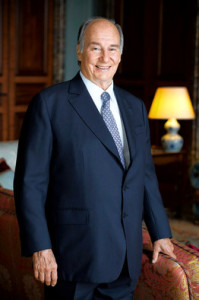September 12-14

Next week, a new museum funded by the Aga Khan and devoted entirely to Islamic art opens in Toronto—the first museum in the Americas focused solely on Islamic art.
Sited near an elevated highway in a middle-class neighborhood, the museum, designed by Pritzker Prize-winning architect Fumihiko Maki, appears futuristic, with milky granite walls crenellated in a few places to make room for angled skylights.
Inside, the galleries are airy but the lights are kept low to protect fragile textiles and works on paper. A huge garden surrounds the museum, speckled with reflecting pools and rows of serviceberry trees and sage.
Prince Shah Karim Al Husseini, 77, is better known by his title of Aga Khan because he serves as spiritual leader for 12 million members of the second-largest branch of Shia Islam, the Nizari Ismaili sect.
Half a century before the royal families of the Arabian Peninsula started buying art, the Aga Khan’s grandfather began amassing art from across the Islamic world. The family has since lent pieces to major museums, but they haven’t displayed the full sweep of their holdings before.
The Aga Khan, in an interview with The Wall Street Journal, said Harvard art historian Stuart Cary Welch encouraged the

family to focus on Islamic art during the 1950s and 1960s.
The current Aga Khan said he was “shocked” when he started college at Harvard in the mid-1950s and found out that his classmates didn’t know much about Islamic art or culture. His peers could rattle off the names of a few European Old Masters and pinpoint ancient styles from China—but none of them recognized a single artist from the Muslim world, he said.
“The inspiration for art isn’t all that different, frankly, across civilizations and time,” he said. “The goal should be to understand the art and those civilizations better, not to criticize or ignore them.”
He began slowly, buying a few artworks after his grandfather died in 1957 and named him the next spiritual leader of his sect at the age of 20.
In 2003, when his uncle died, the Aga Khan and his relatives had to figure out what to do with his uncle’s estate. They decided to pool the Aga Khan’s Mughal collection with his uncle’s broader holdings and create a museum “in a great Western city with no major Islamic collections,” he said.
That ruled out Paris and London, which have encyclopedic museums containing prized Islamic collections. Toronto became the choice because Canada accepted thousands of Nizari Ismailis who were living in Uganda but applied for asylum in 1972 when President Idi Amin expelled Asians.
Today, the Aga Khan said Canada is home to 100,000 Ismailis, and his museum is meant to be an extension of his support for them. He’s also commissioned a community center and prayer hall for them next to the museum.
The museum collection is arranged by media, with sections devoted to: calligraphy and illumination; architectural decoration; ceramics; metalwork; Qorans; luxury objects; painted manuscripts; and objects from science and for learning.
Museum director Henry Kim said during the museum’s debut—it opens September 18—around 300 objects will go on view, with nearly three times as many additional artworks waiting in storage.
The gem of the museum’s permanent collection is its illustrated pages from the Shah Tahmasp Shahnameh. The museum has more than 200 illustrated pages from the Shah-nameh.
One page, “The Court of Keyomars,” shows a scene of the king and his retinue dressed in turbans and animal-print robes sitting amid a golden-indigo paradise of flowers and trees.
“So much of the artistic output of Islamic art is wild fantasy, not religion,” Kim told the Journal. “That’s one of the misconceptions I’d love for the museum to explore.”
